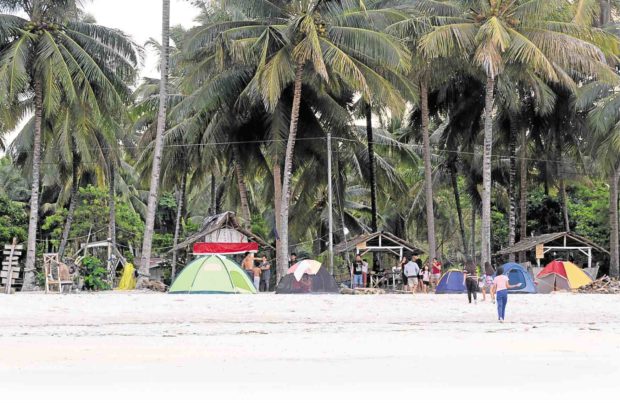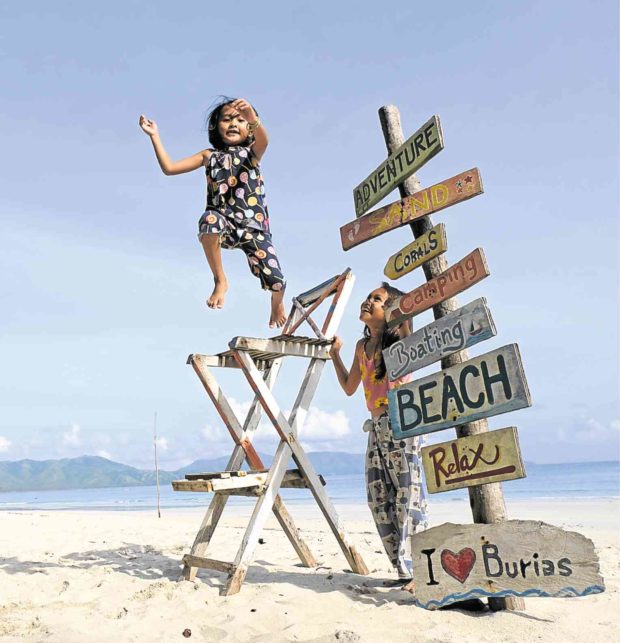
BEACH CAMP Guests pitch tents for an overnight stay at the powdery white sand shoreline of Kingkim beach resort in the village of Burias in Glan, Sarangani. —PHOTO BY BONG S. SARMIENTO
GLAN, Sarangani, Philippines — Over the years, tens of thousands of tourists have flocked to this idyllic century-old town, largely due to the fine, white sand beaches of Barangay Gumasa, popularly known here as the underdeveloped “Boracay of the South.”
But 15 kilometers beyond Gumasa’s famous beaches lies the far more charming, powdery white sand coastline of Barangay Burias, still pristine and offering no-frills adventure and chill time to soothe away the stresses of living.
Burias is fast becoming popular among tourists who are looking for secluded and enchanting swimming spots to relax.
The trip itself provides a refreshing sight. To the left of the concrete, winding road are rolling hills and plains dotted with coconut trees and corn crops, while to the right is the majestic Sarangani Bay.
Rough road
From the main highway, the beaches of Burias can be reached through 3.5 km of rough road but accessible to all kinds of vehicles.

BEACH CAMP The community’s idyllic beach is a playground for local children. —PHOTO BY BONG S. SARMIENTO
Gumasa, about 10 km away from the poblacion, or downtown area, offers a string of well-developed resorts usually packed with tourists during weekends and holidays.
Popularized by the annual staging of the Sarangani Bay Festival, billed as the country’s biggest beach party during summer, Gumasa is the go-to spot for those who love parties and huge crowds.
Most of Glan’s 370,000 tourist arrivals in 2017 went to Gumasa’s resorts.
Social media attention
Burias, though less developed than Gumasa, is beginning to attract tourists, including couples and bikers seeking other beaches in this rustic 104-year-old town.
“Tourists, mostly locals and few foreigners, learned about our place through word of mouth and social media,” Bazaron Kingkim, supervisor of the family-owned Kingkim Beach Resort, told the Inquirer.
Other resorts include Burias Crystal Shore, which is owned by Bazaron’s relatives.
Aside from its secluded spot and the relatively few visitors, the fine white sand and turquoise-clear waters of Burias are the main attractions.
Kingkim Beach Resort offers picnic cottages for P500 overnight. Entrance fees are P40 (whole day) and P70 (overnight) per person.
Private huts for couples or a small family can be rented for P800 per night.
Few amenities
Bazaron advised tourists not to expect many of the usual amenities in the resort, which opened only in October 2017. Toilets-cum-bathing or dressing rooms are few.
While facilities will be improved continuously, Bazaron noted that many of the guests, including foreigners, wanted the place to remain significantly untouched.
Tourists can go for a 10-minute boat ride to Bato Buri, an isolated cove ideal for swimming and snorkeling. The coastline is also covered with fine white sand, while giant rocks in some portions of the cove are backdrops for selfies or group photos.
A round trip costs P100 per passenger.
Dolphins can be spotted farther away from the shoreline, while dugong (sea cows), “pawikan” (turtles) and whales have been documented to frequent Sarangani Bay.
Kingkim Beach Resort sits beside a mosque. As part of the experience in Burias, tourists can mingle with the friendly and hospitable Moro families, said Bazaron, who has Tausug ancestry.
For the community
He assured visitors that the community had peace-loving residents.
The women could cook food for guests, such as rice or freshly caught fish or shellfish at sea. The resort does not have a fixed rate for the service, though.
Eating sea urchins, sold at P5 apiece, is one of the unforgettable things to experience at the resort.
Norsal Kingkim, an imam, or religious leader, in the community and Bazaron’s uncle, hoped that more tourists would come so they could raise money for development.
“We want to put up more basic facilities, not really fancy ones, that will require a huge investment,” he said.
Norsal said more tourists would mean more livelihood opportunities for their community.

